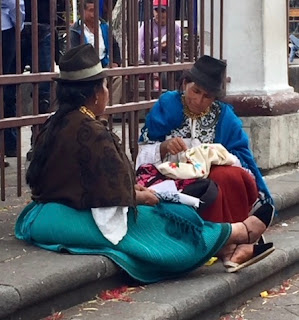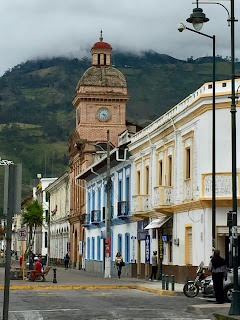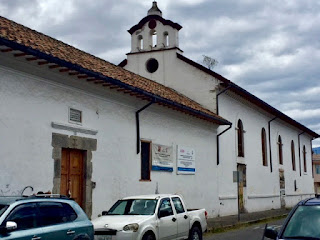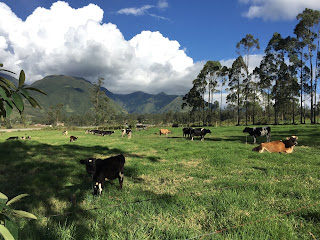I have been in Ecuador for almost 8 months now, and during this time, I've tried hard to get to know people and soak up the culture, absorbing all that is wonderful about Ecuador. But some things, as in any culture, are not so wonderful. Today, I thought I'd give you more of an inside glimpse into the Ecuador that I have witnessed so far.
Things I Love about Ecuador:
Ecuadorians
Ecuadorians are so kind and they love to laugh. They also love to have a good time. One day, I'm sitting alone in the living room of my host family's house during our August training back in Quito, and there's a knock at the door. I open it to 18 people who walk in with a giant cake, a gallon of Fanta and bags of puffed cheetos. Turns out, this day is Santa Rosa and that means a party for all people named Rosa. The grandmother of my family is named Rosa and its a surprise for her. Luckily, my family came home with her a few minutes later and the party began. You have to love a country that has built in so many celebrations!Greetings
"Hola mi amor"... "mi veci"... "mi hija"... "mi corazón". These are the terms of endearment people use to greet each other. "Hello my love", "my neighbor", "my daughter", "my heart" - I've heard them all from friends, and strangers alike, even people younger than I. What's not to like about a greeting that makes you feel so loved?
Cheap Produce
I stop at a vegetable stand in the market to buy a head of broccoli. But then I see the tomatoes and buy 3. The swiss chard looks really fresh, so I get a handful of stalks. And an eggplant, a bag of peas, a handful of radishes, and lettuce for a salad. Finally, red beets- so tempting, I take three of those too. The saleslady throws in a "yapa" of cilantro- an extra for free. Perfect. How much? $3.20.
Cheap Lunches
I love that every town is filled with “Almuerzo” places. This is simply a place that offers a set lunch for a set price- usually $2.00. With your meal, you receive the soup of the day, and a plate full of meat, rice, potatoes, and if you’re lucky, some vegetables, a salad or fruit. Fresh juice is always included as well. The soup and meat choice is listed on the board out front and it’s easy to walk down the street and pick the place that serves what you desire. You sit down. The food is delivered immediately. 20-30 minutes later, you pay when you leave. It’s very simple, and delicious!
Ecuadorians are Connected to their Food Source
 Walk down the street and look into any restaurant and it is common to see a whole pig roasting or splayed out for carving, and whole chickens or cuys (guinea pig) on a spit. Ecuadorians know where their meat comes from (because it was probably killed behind the house that morning), and they know about growing produce for their families. A large part of the population own or work on small farms, or are involved in the distribution of food. Although Ecuador doesn't have "third world chicken buses", I did spot a box of chicks getting brought home from the market.
Walk down the street and look into any restaurant and it is common to see a whole pig roasting or splayed out for carving, and whole chickens or cuys (guinea pig) on a spit. Ecuadorians know where their meat comes from (because it was probably killed behind the house that morning), and they know about growing produce for their families. A large part of the population own or work on small farms, or are involved in the distribution of food. Although Ecuador doesn't have "third world chicken buses", I did spot a box of chicks getting brought home from the market.
Ecuadorians are Politically Active
Everybody knows the history of their country and they keep themselves informed about current politics, and policies of their government at all levels. And they have an opinion about it all, too. The idea that it is their responsibility to be involved in their country is inbred since they are little. This most definitely includes women. 42% of Ecuador's Parliament is made up of women (this ranks 9th in the world). I've sat through several heated discussions involving both men and women regarding the politics of their country and abroad. I think it is great that they are so invested.
Ecuadorians are Hard Workers
They hustle for your money and usually service in stores or restaurants is very quick. They are also entrepreneurial, designing creative ways to make money. For example, a woman who needs to make a living stands on the street corner every morning with a juice press, bags and bags of fresh oranges and two baby carriages. I watch her juggle the babies, and the oranges as she presses fresh juice into bottles and seals them with a twist. I buy one for $1.00. Ecuadorians are Connected to their Food Source
 Walk down the street and look into any restaurant and it is common to see a whole pig roasting or splayed out for carving, and whole chickens or cuys (guinea pig) on a spit. Ecuadorians know where their meat comes from (because it was probably killed behind the house that morning), and they know about growing produce for their families. A large part of the population own or work on small farms, or are involved in the distribution of food. Although Ecuador doesn't have "third world chicken buses", I did spot a box of chicks getting brought home from the market.
Walk down the street and look into any restaurant and it is common to see a whole pig roasting or splayed out for carving, and whole chickens or cuys (guinea pig) on a spit. Ecuadorians know where their meat comes from (because it was probably killed behind the house that morning), and they know about growing produce for their families. A large part of the population own or work on small farms, or are involved in the distribution of food. Although Ecuador doesn't have "third world chicken buses", I did spot a box of chicks getting brought home from the market. Ecuadorians are Politically Active
Everybody knows the history of their country and they keep themselves informed about current politics, and policies of their government at all levels. And they have an opinion about it all, too. The idea that it is their responsibility to be involved in their country is inbred since they are little. This most definitely includes women. 42% of Ecuador's Parliament is made up of women (this ranks 9th in the world). I've sat through several heated discussions involving both men and women regarding the politics of their country and abroad. I think it is great that they are so invested.
Ecuadorians are Hard Workers
Ecuadorians are Resourceful
If they have a task to do, they do it. This man needs to knock down the building. So he and his friend are taking it down- with sledge hammers and mallets- brick by brick. I've spoken in other posts about the lack of school resources. You'd be amazed at what people create out of cardboard boxes, plastic bottles and colored foam.
Things Get Done with a Willing Workforce
I walk past a dirt side street everyday. One day I noticed some men kneeling down and leveling parts of it with piles of dirt and hand shovels. The next day, I saw several stacks of pavers on pallets, obviously having just been delivered. When I looked at the far end of the street, I noticed several men kneeling down, placing brick by brick. In the United States, if we want to build a road, we have to request several designs, put out a contract, hire the lowest bidder, and wait several months before paying thousands of dollars for the heavy equipment and crew to build the road.
I walk past a dirt side street everyday. One day I noticed some men kneeling down and leveling parts of it with piles of dirt and hand shovels. The next day, I saw several stacks of pavers on pallets, obviously having just been delivered. When I looked at the far end of the street, I noticed several men kneeling down, placing brick by brick. In the United States, if we want to build a road, we have to request several designs, put out a contract, hire the lowest bidder, and wait several months before paying thousands of dollars for the heavy equipment and crew to build the road.
In Ecuador, they get some brick pavers and probably some day labors, and they build the road.
When I came back the next day, the road was done and cars were driving on it. Many roads in town have been built by hand either with bricks like these, or small river rock. The roads seem to be durable, and are easy to fix. And they don't take forever to build.
Agreed, there is a problem with underemployment in this country where educated people trained for careers can't find work and have to resort to other jobs to make a living. To build this road, I don’t know what the laborers were paid, but I bet they were happy for the work.
Things Not to Like About Ecuador:
Garbage
Ecuador does have systems to collect and handle their solid waste. In the cities, there are garbage cans and people do use them. But I also see a lot of people just throw their waste on the ground. In every ditch, every empty lot, and every canyon, there is so much plastic garbage: wrappers, take-away food containers, bottles, etc. I step over it all on my walks around town. In such a beautiful country, it makes me sad to see so much garbage strewn across the ground in every direction.
 Dog Poop
Dog PoopThere isn’t a culture of picking up your dog poop here. Large piles decorate the sidewalk and you have to stay diligent when you walk down the street. Since I live in the outskirts of the city, cow patties are also common to find on the sidewalk.
Stray Dogs
There is a lot of dogs wandering the streets. Some may have owners, but that's a loose interpretation. When they travel in packs, they tend to get pretty aggressive. One day I was waiting for a bus in a small town and I counted 11 stray dogs on the corner with me. The government, with the help of Vet Students, is trying to spay or neuter these dogs, but it's a slow process.
Cheek-to-Cheek Greetings
If done properly, you should only be touching cheeks. But there are a lot of men who love to plant a slobbery wet-one right on your face. Also, inevitably throughout the day you come upon someone who has applied a little too much cologne or perfume so you end up smelling like them all day too. It's really too much and its hard to avoid.
Starch, Starch, Fat, and More Starch
Sharing Glasses
At a party, it's very common to serve a bottle of beer (or something stronger) to all your guests with only one glass. The beverage is poured, the first person downs the drink, and passes the cup to the next person for a refill. I always try to get the first drink so I don't have to share the glass.
Mountains of rice, piles of potatoes, and corn in every variation is served at every meal in the Sierra Region. And don't forget the bread rolls and the banana for dessert. I like the food here, but I really search out opportunities to eat something with a different flavor. It is possible to find some Columbian and Venezuelan restaurants, but they're only open for dinner. Chinese is also common here, but unfortunately, it's heavy on rice and salt. And of course, "American food" is a favorite. If I wanted to fill up on french fries, hot dogs, fried chicken, pizza or hamburgers, then there is plenty of selection on every corner.
Things That Are Just Hard:
Every culture has their own way of interacting. For me, one the hardest (and most exhausting) things about living in another country is trying to navigate their different styles of communication, while also trying to remember how to speak in their language. I've learned that my direct, sometimes zealous, Type A approach to communication and solving problems is usually not successful in Ecuador, so interacting with people at work and home has sometimes been a challenge. From what I've ascertained so far, we have very different ways to give greetings and say goodbyes, give opinions, show appreciation, ask questions, dispense information, provide answers, express concerns, solve problems, ask for favors, convince someone to do something, respond to requests, decline an invitation, and give and receive gifts. That's a lot to be aware of in every interaction. Simply walking into a room when you're in a hurry and giving a quick "Hello" to a group of people is a major no-no. If you don't take the time to greet everyone individually (yes, even in a very large group), you are seen as rude. I know I've made some people mad or hurt some feelings. Those who have had some connection with Americans before tend to be a little forgiving when I make a faux pax. Navigating this path will definitely be a work in progress for me throughout my service.
Looking for My People
As I'm working within the Peace Corps, my school, my home, the University, my Spanish classes, my art classes and my inter-cambios, I'm meeting a lot of people from both the US and Ecuador. But in all my interactions here in Ibarra, I haven't yet found "my people". That's hard. I'm living a fun adventure, but sometimes, it's a little lonely. I'm working on getting used to that, too.
Looking for My People
As I'm working within the Peace Corps, my school, my home, the University, my Spanish classes, my art classes and my inter-cambios, I'm meeting a lot of people from both the US and Ecuador. But in all my interactions here in Ibarra, I haven't yet found "my people". That's hard. I'm living a fun adventure, but sometimes, it's a little lonely. I'm working on getting used to that, too.
In my next post, I'll give you some more insight into living at the Equator!
Stay Tuned!
Stay Tuned!


































































